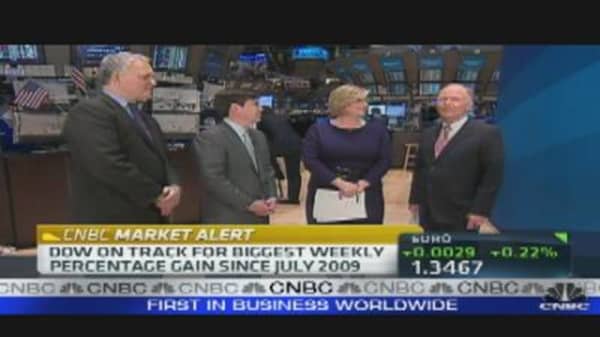November's employment report is expected to show improvement over last month but still portray a very weak hiring picture.
Economists have been forecasting a total 125,000 non-farm payrolls were added in November, but that number could disappoint markets that are geared up for a slightly better number.
The economists forecast that the private sector added a total 150,000 jobs in November, which were offset by layoffs in the public sector. The unemployment rate is expected to hold steady at 9 percent, when the report is released at 8:30 a.m. EST Friday.
"We've become somewhat biased for a stronger-than-expected number," said David Ader, head of Treasury strategy at CRT Capital. "Whisper numbers are 150,000, 175,000" for private payrolls, slightly better than the consensus. In October, a total 80,000 payrolls were added, with private sector jobs at 104,000.
One bright spot in November may have been hirings by new businesses, but that is not likely to be reflected in the employment report since the government data is slow to reflect them, according to Mesirow Financial chief economist Diane Swonk. Wednesday's private sector employment report from ADP showed a surprising increase of 110,000 new small business hires.
Swonk said these types of jobs typically show up later in revisions to the government data. She expects to see a total 140,000 non farm payrolls, with 160,000 hires in the private sector.
"It does look like we're getting an increase in small business births...over half of the increase in the ADP data is small businesses. Usually, when you have that kind of a pickup, it's indicative of small businesses starting," she said.
Swonk said existing small businesses remain pessimistic, and it is doubtful they are doing much hiring. But another encouraging sign is the increase in initial public offerings because young companies are more inclined to add workers.
"It bothers me that mergers and acquisitions are so strong because that's people hunkering down rather than expanding. The merger activity we've seen is more defensive," she said. "There are a lot of cross currents."
The November jobs report could be impacted just slightly by holiday-related hiring, but that impact is muted by seasonal adjustments, made to smooth out the numbers. November is usually the biggest month for holiday retail hiring.
"We have seen over the last couple of years, retail trade hiring increasing slowly but steadily," said Gus Faucher, director of macroeconomics at Moody's Economy.com. He expects retailers to be hiring more this year, and that could be a beneficial ripple for the economy but not a big factor in the jobs report.
Job increases, however, are more likely to show up in things like manufacturing. "We expect to see increases in goods producing industries, so manfuacturing in particular and construction, to a lesser extent, are probably adding to job growth," he said.
Faucher said job gains are likely to continue to be slow. "I think at the end of next year it will be 150,000 (a month), and 250,000 to 300,000 at the end of 2013," he said. The unemployment rate is also not likely to come down signficantly until the end of next year.
"I think by the second half of next year, we're going to be in a self-sustaining expansion. That's what's going to cause the hirings to kick into a higher gear," Faucher said.
Several economists raised their forecasts Wednesday, after ADP's private sector report showed an increase of 206,000 private sector jobs.
While ADP has not been an accurate predictor of jobs, economists note there are other factors that point to slight improvement. They have been monitoring improvement in weekly jobless claims reports, which had been below 400,000 for several weeks, but rose slightly above that to 402,000 this week.
The claims number may have dampened some of the enthusiasm around ADP's report but the ISM manufacturing survey released Thursday showed better than expected expansion in manufacturing activity and stronger order growth.
Credit Suisse economist Jonathan Basile raised his payrolls estimate Wednesday to a total 170,000 nonfarm payrolls from 130,000. Deutsche Bank raised its forecast to 150,000 from 125,000, and Capital Economics was reported to have raised its expectation to 140,000 from 100,000.
Goldman Sachs Thursday raised its forecast to 125,000 from 100,000 non farm payrolls, based on this week's data.
"There's some fundamental reason why job growth can be stronger and there's some technical reasons," said Basile. "We upped our numbers because the ADP is stronger than thought. I think people say there tends to be an overstatement in November by this report, but we'll see what it says Friday because there are other reasons. Fundamental ones. Job openings are up. Firings are down."
Basile said the labor department JOLTS report showed an increase in job openings, and the consumer confidence data Tuesday showed a better attitude about jobs.
"ADP told us an awful lot of small businesses hired. They had the biggest increase in five years for small business hiring. It was 110,000 for the month," he said.
"It continues to speak to the current economic difficulites—the fact we would celebrate 160,000 jobs, if I'm right. It speaks to the current state of the economy and how low expectations have gotten," said Dan Greenhaus, global strategist with BTIG.
While better, the level of employment gains is still below what is needed to bring down the unemployment rate.
"Our forecast would imply it's getting better than last month...Jobless claims are getting lower, and it doesn't look like the labor market has deteriorated," said Goldman Sachs economist Andrew Tilton. "In the employment growth side, it seems things are steady to a bit stronger."
Follow Patti Domm on Twitter: @pattidomm





